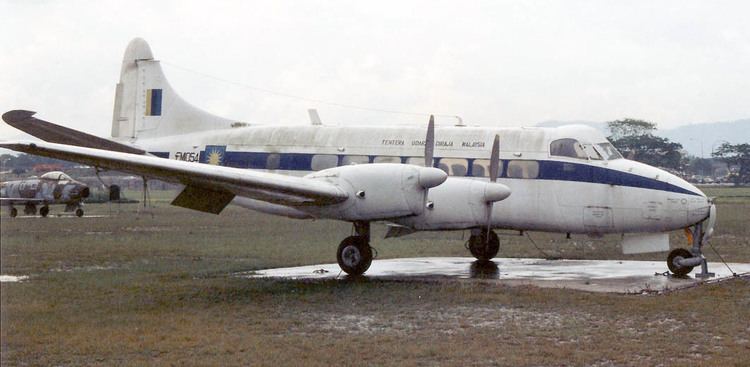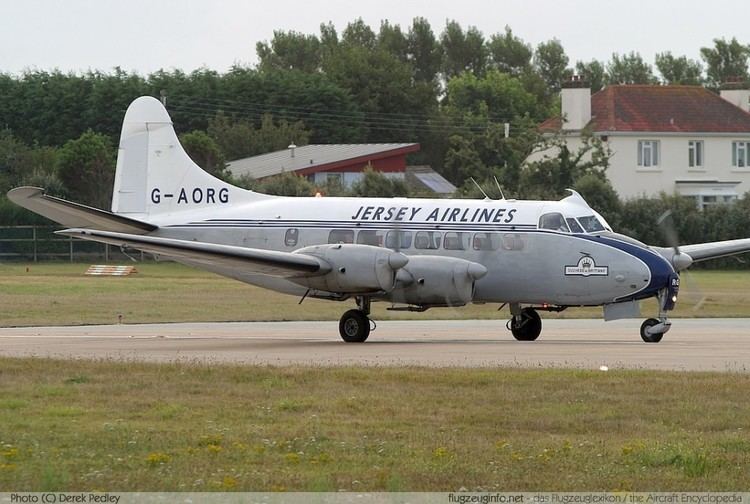Length 15 m Introduced 1950 First flight May 10, 1950 | Wingspan 22 m | |
 | ||
The de Havilland DH.114 Heron was a small propeller-driven British airliner that first flew on 10 May 1950. It was a development of the twin-engine de Havilland Dove, with a stretched fuselage and two more engines. It was designed as a rugged, conventional low-wing monoplane with tricycle undercarriage that could be used on regional and commuter routes. 150 were built, also exported to about 30 countries. Herons later formed the basis for various conversions, such as the Riley Turbo Skyliner and the Saunders ST-27 and ST-28.
Contents
- Design and development
- Operational service
- Popular culture
- Variants
- Military operators
- Civil operators
- Accidents and incidents
- Specifications Heron 2D
- References

Design and development

Immediately after the Second World War, the aircraft manufacturer de Havilland developed the DH.104 Dove, a small twin-engined passenger aircraft intended as a replacement for the earlier Dragon Rapide, which soon proved to be successful. As a further development, the company basically enlarged the Dove; the fuselage was lengthened to make room for more passengers or freight, and the wingspan was increased to make room for two more engines. The Heron was of all-metal construction, and was laid out as a conventional design; the resulting aircraft could use many of the parts originally designed for the Dove, thus simplifying logistics for airlines using both types.

The emphasis was on rugged simplicity to produce an economical aircraft for short- to medium-stage routes in isolated and remote areas which did not possess modern airports. The Heron was designed with a fixed undercarriage and reliable ungeared unsupercharged Gipsy Queen 30 engines.

The Heron prototype registered to the de Havilland Aircraft Company, Hatfield, UK as G-ALZL undertook its first flight with Geoffrey Pike at the controls on 10 May 1950. The aircraft was unpainted at the time, and after 100 hours of testing was introduced to the public on 8 September 1950 at the Farnborough Airshow, still glistening in its polished metal state. By November, the prototype had received its formal British Certificate of Airworthiness and had flown to Khartoum and Nairobi for tropical trials.

The prototype was then painted and fitted out as a company demonstrator, and was tried by British European Airways in 1951 on their Scottish routes. Following the successful completion of the prototype trials as a regional airliner, series production of the Heron began. The first deliveries were to NAC, the New Zealand National Airways Corporation (later part of Air New Zealand).
Basic price for a new Heron in 1960 was around £60,000, minus radio.
Operational service

The first Heron, Series 1A suffered deficiencies, as NAC soon discovered. First, the aircraft was generally underpowered. Its quite heavy engines (weighing about 880 pounds (400 kg) each), had an output of only 250 hp (190 kW) each. By comparison, later modifications or rebuilt aircraft had as much as 50% more power (in the case of the Saunders ST-27). Unlike the Dove, the Heron came with a fixed undercarriage and no nosewheel steering, which simplified maintenance, but reduced top speed. Secondly the lightweight aluminium alloy wingspars were prone to constant cracking due to the heavy loading on the wing caused by the overweight engines and rough landings on unpaved runways at the time. NAC resolved this by replacing the aluminium spars with heavier steel spars, reducing the performance of the Heron Series 1A (re-classified 1B) to uneconomic levels for the services required of them in New Zealand. NAC disposed of them in 1957.
After 51 Series 1 aircraft had been built, production switched to the Series 2, featuring retractable landing gear, which reduced drag and fuel consumption, and increased the top speed marginally. The 2A was the equivalent of the 1A, the basic passenger aircraft while the 1B and its successor the 2B had higher maximum takeoff weight, the 2C featured fully feathering propellers, the Heron 2D had an even higher maximum takeoff weight, while the Heron 2E was a VIP version.
In service, the Heron was generally well received by flight crews and passengers who appreciated the additional safety factor of the four engines. At a time when smaller airliners were still rare in isolated and remote regions, the DH.114 could provide reliable and comfortable service with seating for 17 passengers, in individual seats on either side of the aisle.
With its larger fuselage, passengers could stand up whilst moving down the aisle and large windows were also provided. Baggage was stored in an aft compartment with an additional smaller area in the nose. A few peculiarities appeared; passengers who filled the aft rows first would find that the Heron gently "sat down" on its rear skid. Pilots and ground crews soon added a tail brace to prevent the aircraft from sitting awkwardly on its tail.
Performance throughout the Heron range was relatively "leisurely", and after production at de Havilland's Chester factory ceased in 1963, several companies, most notably Riley Aircraft Corporation, offered various Heron modification "kits," mainly related to replacing the engines, which greatly enhanced takeoff and top speed capabilities. Riley Aircraft replaced the Gipsy Queens with horizontally-opposed Lycoming IO-540 engines.
One U.S. airline that carried out Riley-type conversions at their Opa Locka Airport Florida engineering facility was Prinair, of Puerto Rico, which replaced the Gipsy Queens with Continental IO-520 engines. Prinair also considerably stretched Heron 2 N574PR to allow extra passengers to be carried.
Connellan Airways also converted its Herons, using Riley kits. When available aircraft reached the end of their service lives, the engine conversions gave the elderly airliner a new lease on life as a number of examples were converted in the 1970s and 1980s including N415SA, a Riley Heron still flying in Sweden as of 20 May 2012 and a Riley Turbo Skyliner, tail number N600PR currently registered in the United States (this example appeared in the 1986 movie Club Paradise).
The most radical modification of the basic Heron airframe was the Saunders ST-27/-28, that basically changed the configuration as well as the "look" of the whole aircraft with two powerful turboprop engines replacing the lethargic four-engine arrangement, the easily recognisable "hump" over the cockpit disappearing, the shape of the windows changed and the wingtips squared instead of rounded.
Popular culture
The de Havilland Heron is used in the book series Flight 29 Down. A Heron is also featured in Khufra Run by Jack Higgins.
A Riley Turbo Skyliner variant was used in the 1986 US comedy film Club Paradise
Variants
Military operators
Civil operators
Accidents and incidents
Specifications (Heron 2D)
Data from De Havilland Aircraft since 1909
General characteristics
Performance
